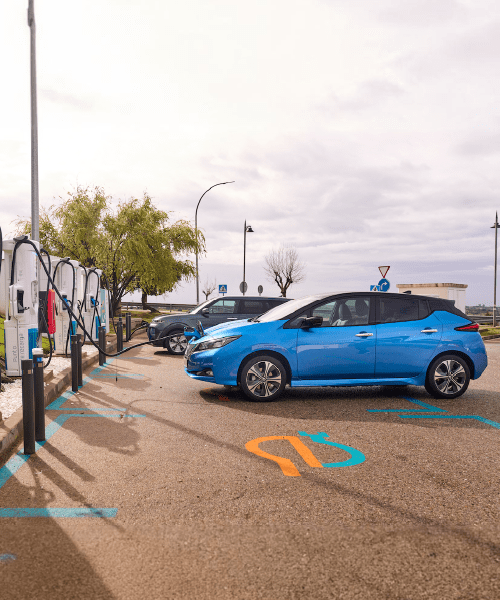All about HVO or hydrobiodiesel
All about HVO or hydrobiodiesel
Reusing resources
Reusing resources
The promotion of renewable energy sources is a reality that goes beyond hydroelectric plants, photovoltaic panels, or wind farms. The field of renewable fuels is a good example of this and, in recent years, the commitment to finding technological solutions that allow reducing the carbon footprint in the mobility sector is a constant.
HVO (Hydrotreated Vegetable Oil) or hydrobiodiesel, is gaining popularity and is already marketed both in Spain and in other European countries such as Finland, Latvia, Lithuania, and Estonia.
In addition to being a low-emission fuel, HVO promotes the reuse of resources, improves engine performance, and contributes to the transition to a future with lower CO2 emissions.
What is HVO or hydrobiodiesel fuel?
What is HVO or hydrobiodiesel fuel?
HVO or hydrobiodiesel is a biofuel that is produced from organic waste such as recycled vegetable oils and animal fats. Unlike conventional biodiesel, which is obtained by a chemical process of transesterification (a method that converts oils or fats into biodiesel by exchanging components with an alcohol), HVO is produced by hydrogenation. This process improves the quality of the resulting fuel by removing impurities, increasing its stability and performance, and producing a fuel with better combustion properties.
In practice, hydrogenation involves the addition of hydrogen to oils and fats under high temperatures and pressure, removing oxygen and creating a chemical structure similar to that of diesel of mineral origin, but with a significantly smaller carbon footprint. This feature is one of the main attractions of hydrobiodiesel.
.jpg.transform/rp-rendition-lg/image.jpeg)
Advantages of HVO
Advantages of HVO
Committing to renewable fuels such as HVO contributes to reducing the carbon footprint, but the advantages of hydrobiodiesel go further. Here are some of the standouts:
- Reduction of CO2 emissions. HVO allows for a significant reduction in carbon dioxide emissions compared to traditional diesel. According to the international study The significance of low carbon bio-alcohols and bio-ketones fuels for clean propulsion systems, -focused on researching how to reduce vehicle emissions without affecting engines-, in which the Universidad de Málaga and the Future Power Systems Group of the University of Birmingham (United Kingdom) have participated, this hydrobiodiesel can reduce up to 90% of CO2 emissions into the atmosphere.
- Improved air quality. Hydrobiodiesel produces fewer emissions of gases such as sulfur dioxide (SO2), nitrogen oxides (NOx), and other fine particles, improving air quality and, consequently, minimizing health risks.
- Compatibility with existing engines. HVO can be used in diesel engines without modifications, which facilitates its adoption by fleets of vehicles and agricultural and industrial machinery.
- Improved performance and useful life of engines. This type of renewable fuel generates less waste in the engine, prolonging its useful life and reducing maintenance costs. In addition, thanks to its higher cetane number, HVO can improve engine performance and reduce consumption which, in practice, also means economic savings.
- Optimization of resources and new opportunities. By using recycled oils and fats, hydrobiodiesel promotes an economy that optimizes the use of waste. In this way, new economic and job opportunities in sectors such as recycling and biofuel production are added to the environmental benefit.
How is HVO produced?
How is HVO produced?
Producing hydrobiodiesel is something like doing alchemy with something as everyday as used vegetable oils (from those used at home, to those from restaurants or the food industry) and animal fats. Production is divided into several stages:
- Collection and pretreatment of raw materials
It all starts with the collection of used vegetable oils and animal fats which, as we said, are common waste in many kitchens. These oils and fats are pretreated to remove impurities and contaminants, ensuring that only quality materials are used. - Hydrogenation
Once cleaned, the raw materials are subjected to a hydrogenation process and then subjected to the action of high temperatures and pressure in the presence of a catalyst. This process, known as hydrogenation, removes oxygen from oils and fats, converting them into hydrocarbons, which are the basis of HVO. - Isomerization
The resulting hydrocarbons go through a process called isomerization. This step improves the qualities of the fuel, such as its fluidity at low temperatures, making it ideal for use in various climatic conditions. At this stage, the atoms within the molecules that make up the fuel are rearranged - through different chemical reactions - in order to improve properties. - Distillation and refining
Finally, the product goes through distillation and refining, where any unwanted residue is removed. This step ensures that the HVO is a high-quality fuel, ready to be used in diesel engines without any problems.
Repsol and 100% renewable fuels
Repsol and 100% renewable fuels
Achieving a low-carbon future depends, to a large extent, on innovation. In the renewable fuels sector, the types and applications we develop at Repsol stem from this commitment to the search for innovative solutions. Within this chapter, however, it is worth distinguishing between synthetic fuels or e-fuels - still in the experimental phase - and biofuels, which are already a reality and are available in an increasing number of our service stations in the iberian peninsula.
An example of this is Repsol Nexa Diesel, formulated on the basis of the company's HVO, 100% renewable and which also has the premium additive package. It is important to note that being the leading producer of HVO in the iberian peninsula, as well as the first marketer for the end customer of 100% renewable fuels in Spain, is the result of years of research in our R&D center, Repsol Technology Lab. In fact, we have the first large-scale 100% renewable fuel plant in the iberian peninsula, a project that represents a new step towards mobility aimed at reducing carbon emissions. This plant, located in Cartagena, has the capacity to produce HVO and other biofuels from raw materials of organic origin.
Another example of technological innovation is biofuels for aircraft (biojet, or SAF, Sustainable Aviation Fuel), which are the main lever to reduce CO2 emissions in the aviation sector, since in their entire life cycle they avoid up to 80% of them. Recently - together with Iberia - we have signed an agreement with Inditex that allows Repsol's SAF to represent 5% of the fuel that Iberia uses to transport Inditex merchandise on its flights.
The materialization of these and other actions is observed in agreements such as the one reached with the Sesé logistics and transport group. Under the agreement, Repsol will supply eight million litres of hydrobiodiesel over the next two years to vehicles in the company's fleet. The agreement joins similar ones signed with different companies, in order to reduce transport emissions through our 100% renewable fuels.
New refueling alternatives
Discover the renewable fuel alternatives for transport
.png)

